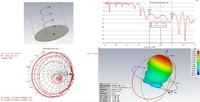DeboraHarry
Full Member level 5
I've made a helical antenna for 2.45 GHz which consists of 130 mm diameter ground plane, a helix of 39 mm diamater with a pitch of 27 mm. The conductor is self-supporting and is 1.2 mm diameter enamled copper wire. I had 7 turns, but cut it down a bit later. The helix is in the middle of the gound plane, with an N connector about 20 mm off centre, so the outside of the helix connects to the N connector.
I've measured the input impedance on a VNA, and get nothing like the resistive 140/150 Ohms I would expect. I'm guessing with 4 turns:
31 - j 30 Ω at 2.0 GHz
20 - j 10 Ω at 3.0 GHz.
with 7 turns I had
35 - j 48 Ω at 2.0 GHz
21 - j 31 Ω at 2.45 GHz
16 - j 18 Ω at 3.0 GHz
The former I used to wind the helix was a bit different between these two setups, so the helix would have changed a bit in diameter and pitch.
But no matter what I try, a sweep of the helix over the 2-3 GHz range show it is is nowhere near resonance, and sitting towards the bottom left of a Smith chart, rather than to right of centre as I'd expect with the theoretical 140 of so Ohms.
As far as I'm aware, the dimensions are not critical, so whilst I don't claim this helix has exactly the dimensions I want, the fact the real part of the input impedance is off by a factor of about 6 is a bit worrying.
I've tried calibrating the VNA using three different cables, using both ports. I get basically the same result each time. The short/open/load were connected directly to the end of the cable when calibrating the VNA, so the N connector on the cable should measure the impedance at the N connector on the ground plane, where it was directly attached. (Obviously if I had a length of cable, I might expect this to change the impedance
I've checked the VNA (an HP one) reads basically 0.0 with a short, infinity with an open and 50 Ohms with a load. So the VNA seems to be working ok.
Any ideas?
I've measured the input impedance on a VNA, and get nothing like the resistive 140/150 Ohms I would expect. I'm guessing with 4 turns:
31 - j 30 Ω at 2.0 GHz
20 - j 10 Ω at 3.0 GHz.
with 7 turns I had
35 - j 48 Ω at 2.0 GHz
21 - j 31 Ω at 2.45 GHz
16 - j 18 Ω at 3.0 GHz
The former I used to wind the helix was a bit different between these two setups, so the helix would have changed a bit in diameter and pitch.
But no matter what I try, a sweep of the helix over the 2-3 GHz range show it is is nowhere near resonance, and sitting towards the bottom left of a Smith chart, rather than to right of centre as I'd expect with the theoretical 140 of so Ohms.
As far as I'm aware, the dimensions are not critical, so whilst I don't claim this helix has exactly the dimensions I want, the fact the real part of the input impedance is off by a factor of about 6 is a bit worrying.
I've tried calibrating the VNA using three different cables, using both ports. I get basically the same result each time. The short/open/load were connected directly to the end of the cable when calibrating the VNA, so the N connector on the cable should measure the impedance at the N connector on the ground plane, where it was directly attached. (Obviously if I had a length of cable, I might expect this to change the impedance
I've checked the VNA (an HP one) reads basically 0.0 with a short, infinity with an open and 50 Ohms with a load. So the VNA seems to be working ok.
Any ideas?


